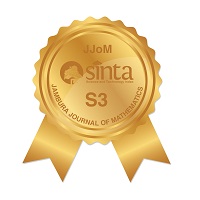Perbandingan Propensity Score Stratification dan Propensity Score Matching dengan Pendekatan Multivariate Adaptive Regression Spline
Abstract
Keywords
Full Text:
PDFReferences
IDF, "Indonesia Diabetes Report 2000 - 2045" 2024. [Online] Available: https://diabetesatlas.org/data/en/country/94/id.html. [diakses Jun 19, 2024].
E. Ernawati, B. W. Otok, dan S. Sutikno, "Penggunaan Propensity Score Stratification-Support Vector Machine Untuk Mengestimasi Efek Perlakukan Aktivitas Olahraga Pada Penderita Diabetes Melitus" Indones. J. Stat. Its. Appl., vol. 4, no. 3, pp. 510-527, 2020. doi: 10.29244/ijsa.v4i3.653.
N. Faulina, K. Nisa, D. Aziz, dan E. Setiawan, "Analisis Propensity Score Matching Pada Kejadian Diabetes Melitus Yang Memuat Faktor Confounding" J. Siger Mat., vol. 02, no. 02, pp. 43-51, 2021.
L. Meuli dan F. Dick, "Understanding Confounding in Observational Studies" Eur. J. Vasc. Endovasc. Surg., vol. 55, no. 5, p. 737, 2018. doi: 10.1016/j.ejvs.2018.02.028.
I. R. Akolo, B. W. Otok, S. W. Purnami, dan R. Hiola, "Propensity Score Stratification Analysis using Logistic Regression for Observational Studies in Diabetes Mellitus Cases" in Proceeding of 3rd International Conference on Research, Implementation and Education of Mathematics and Science, 2016, pp. 59-66.
A. Adityaningrum, "Estimasi Propensity Score Matching Berdasarkan Pendekatan Multivariate Adaptive Regression Splines" Institut Teknologi Sepuluh Nopember, 2017.
A. Wahyuni, "Propensity Score Stratification (PSS) Menggunakan Multivariate Adaptive Regression Spline (MARS) Pada Kasus Diabetes Melitus Tipe 2" Institut Teknologi Sepuluh Nopember, 2019.
J. L. Adelson, D. B. McCoach, H. J. Rogers, J. A. Adelson, dan T. M. Sauer, "Developing and applying the propensity score to make causal inferences: Variable selection and stratification" Front. Psychol., vol. 8, pp. 1-10, 2017. doi: 10.3389/fpsyg.2017.01413.
H. Nisa', "Perbandingan Propensity Score Weighting dan Matching menggunakan Regresi Logistik (Studi Kasus: Data Kelulusan ASI Eksklusif di Kecamatan Selopuro Kabupaten Blitar)" Universitas Brawijaya, 2019.
U. Benedetto, S. J. Head, G. D. Angelini, dan E. H. Blackstone, "Statistical primer: Propensity score matching and its alternatives" Eur. J. Cardio-thoracic Surg., vol. 53, no. 6, hal. 1112-1117, 2018, doi: 10.1093/ejcts/ezy167.
M. R. Mattalunru, S. Annas, dan M. K. Aidid, "Aplikasi Multivariate Adaptive Regression Splines (Mars) Untuk Mengetahui Faktor Yang Mempengaruhi Curah Hujan Di Kota Makassar" VARIANSI J. Stat. Its Appl. Teach. Res., vol. 4, no. 1, pp. 9-19, 2022. doi: 10.35580/variansiunm2.
B. W. Otok, A. Aisyah, Purhadi, dan S. Andari, "Propensity score matching of the gymnastics for diabetes mellitus using logistic regression" AIP Conf. Proc., vol. 1913, 2017. doi: 10.1063/1.5016668.
S. Anam, S. Sugiman, dan S. Sunarmi, "Ketepatan Klasifikasi dengan Menggunakan Metode Multivariate Adaptive Regression Spline (MARS) Pada Data Kelompok Rumah Tangga Kabupaten Cilacap" UNNES J. Math., vol. 6, no. 1, pp. 92-101, 2017.
S. Hasanah, B. W. Otok, dan A.Adeni, "Perbandingan Metode Propensity Score Matching-Support Vector Machine dan Propensity Score Matching-Regresi Logistik Biner Pada Kasus HIV/AIDS" Sainmatika J. Ilm. Mat. dan Ilmu Pengetah. Alam, vol. 18, no. 1, p. 93, 2021. doi: 10.31851/sainmatika.v17i3.4925.
P. C. Austin dan E. A. Stuart, "The Effect of A Constraint on The Maximum Number of Controls Matched to Each Treated Subject on The Performance of Full Matching on The Propensity Score When Estimating Risk Differences" Stat. Med., vol. 40, no. 1, hal. 101-118, 2021, doi: 10.1002/sim.8764.
DOI: https://doi.org/10.37905/jjom.v6i2.26137
Copyright (c) 2024 Ingka Rizkyani Akolo, Setia Ningsih, Hendra Dukalang

This work is licensed under a Creative Commons Attribution-NonCommercial 4.0 International License.
Jambura Journal of Mathematics has been indexed by
Jambura Journal of Mathematics (e-ISSN: 2656-1344) by Department of Mathematics Universitas Negeri Gorontalo is licensed under a Creative Commons Attribution-NonCommercial 4.0 International License. Powered by Public Knowledge Project OJS.
Editorial Office
Department of Mathematics, Faculty of Mathematics and Natural Science, Universitas Negeri Gorontalo
Jl. Prof. Dr. Ing. B. J. Habibie, Moutong, Tilongkabila, Kabupaten Bone Bolango, Gorontalo, Indonesia
Email: [email protected].



















